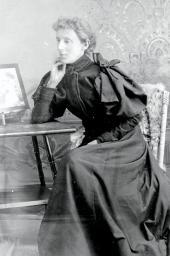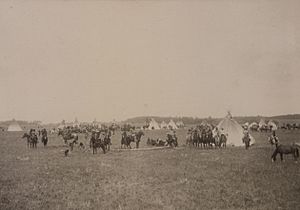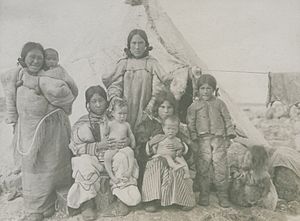Geraldine Moodie facts for kids
Quick facts for kids
Geraldine Moodie
|
|
|---|---|

Self portrait by Moodie
|
|
| Born |
Géraldine Fitzgibbon
31 October 1854 Toronto, Canada West
|
| Died | 4 October 1945 (aged 90). |
| Nationality | Canadian |
| Known for | photographer |
Geraldine Moodie (born October 31, 1854 – died October 4, 1945) was a Canadian photographer. She was one of Canada's first professional female photographers. Moodie took many important pictures of early Canadian history. She is especially known for her photos of indigenous peoples in Northern Canada. She opened her own photography studios in places like Battleford, Saskatchewan, and Medicine Hat, Alberta.
About Geraldine Moodie
Géraldine Fitzgibbon was born in Toronto, Canada, on October 31, 1854. At that time, Toronto was part of a region called Canada West. Her parents were Agnes and Charles Fitzgibbon.
Geraldine was the granddaughter of a famous author named Susanna Strickland Moodie. She was also related to another well-known writer, Catherine Parr Traill.
In 1878, Geraldine married John Douglas Moodie in England. He was a distant relative of hers. The couple moved back to Canada and lived in Manitoba for a short time. Later, they moved to Ottawa.
In 1885, her husband joined the North-West Mounted Police (NWMP). Geraldine and John had six children together. Even though it was a time when men mostly held important jobs, Geraldine became a very successful photographer.
Her Photography Work
Geraldine Moodie took many different kinds of pictures. She photographed people, including members of the mounted police. She also took pictures of ranching life and beautiful wildflowers.
She often traveled with her husband, John Douglas Moodie. During these trips, she photographed the Innu people near Hudson Bay between 1904 and 1909. She also took pictures around the city of Regina from 1910 to 1911.
Many of her photographs were connected to her husband's work with the Canadian Pacific Railway. Her pictures helped explain his reports to important people like Prime Minister Wilfrid Laurier.
Geraldine wrote about how she had to change her photography methods. This was because of the bright glare from the snow and the very cold weather.
In 2017, some of her work was shown in an exhibition. It was called North of Ordinary, The Arctic Photographs of Geraldine and Douglas Moodie at the Glenbow Museum.
Her Lasting Impact
Geraldine Moodie passed away in 1945 when she was 90 years old. She was buried in Burnsland Cemetery in Calgary, Alberta, Canada.
Her photographs are now kept in important museum collections. These include the Glenbow Museum in Alberta, Canada, and the British Museum in London, England.
On March 22, 2013, Canada Post released a special stamp. It featured one of Moodie's photographs called Koo-tuck-tuck. This picture shows an Inuit woman dressed in traditional clothing.



